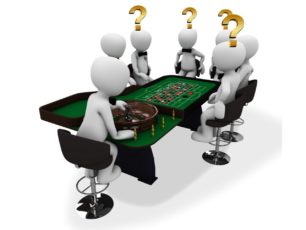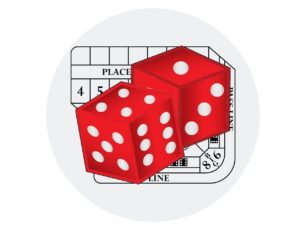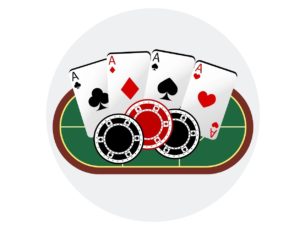How do you Play Blackjack?
As with many things that need to be learned, we must first learn how to play blackjack online before we strategize for it. Luckily for us, blackjack is one of the simplest deck games out there—the goal is simply to get a hand value larger than the dealer's without going over 21. With that in mind, let's try playing a game of blackjack, but broken down step by step:
- The players place their bets, then signal the dealer to start the game when everyone is ready.
- The dealer deals out two cards for their and the players' hands. All of the cards are dealt face-down except for the dealer's second card, which is dealt face-up. (From this point on, the dealer's face-up card will be called the upcard and the face-down card will be called the hole card.)
- Each player is given the chance to make one of 6 decisions, from which much of the strategy of the game emerges. These decisions are:
- Hit: The player is dealt an extra card. This can usually be done up to a limit of 5 times or until the player goes bust.
- Stand: The player doesn't take any more cards and ends their turn.
- Double down: The player doubles their bet and is dealt only one extra card.
- Split: The player splits their first two cards into two hands, each with their own bets, and is dealt their extra card. This can only be done if the player's first two cards have the same value (also called doubles).
- Surrender: The player forfeits half of their bet and sits out until the next game.
4. The dealer shows all the cards in play. Any player hands with a blackjack (a 10 card and an ace) or a value higher than the dealer's wins, and a new game starts afterward.
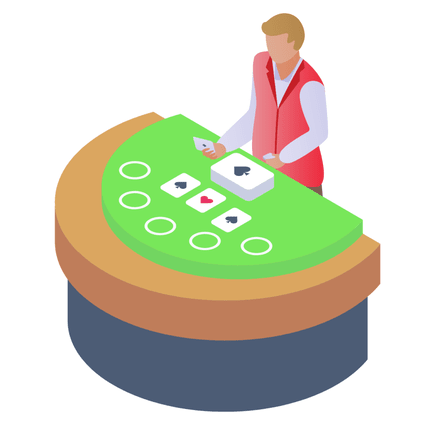
What Variations of Blackjack are there?
The format of blackjack that we just learned is the most common variant you’ll encounter at any live casinos in Canada. However, some games will have variations to the standard rules to make the game more interesting or drive away cheaters. It would be quite impractical to list and describe all of them here, though, so to save you time, we’ve compiled some of the most common ones you’ll find.
Classic Blackjack
No gimmicks, no fuss, no drama – online classic blackjack is the casino blackjack you know and love. With up to 8 decks in play and as many as 8 players around the table, classic blackjack rules is the best test of your strategy and luck and is arguably the purest way to play blackjack.
Premium Blackjack
Don’t be too intimidated by the “premium” wording – the rules in Premium Blackjack are really not all that different from the standard version. The Premium namesake instead refers to the higher stakes of the game, which raises your buy-in cost but also raises your payouts when you land a win.
Shoe Size Rule
No, this isn’t about footwear; the “shoe” refers to the container for the decks of cards that are used in the game. As blackjack in Canada is played with a single deck up to an 8-deck shoe, there is a lot of variation here; but generally, players will have better odds of winning in a single deck game as opposed to a multi-deck game.
Soft 17 Rule
“Stand on soft” or “stand on hard”? This is the question answered by the soft 17 rule, one of the most common rules that casinos can’t really agree on. Simply put, this rule refers to the instruction that casinos give to their dealers if their hand is a soft 17 (a 17 with an ace). As a result, you may find “dealer stands on soft 17” or “dealer hits on soft 17” on the table layout (typically shortened to S17 or H17, respectively). Based on analysis of the game and application of blackjack strategy, playing S17 games tend to be more advantageous to the player.
Double Exposure
In this variation, both of the dealer’s cards are dealt face-up, removing much of the guesswork that basic strategy was made to compensate for. Of course, the casino would not give up their house edge so easily, so some rules had to be changed to compensate. Some of these new rules include: even payouts on blackjack (instead of the typical 3:2); a loss instead of a push (bets are returned) if the player and dealer tie; and surrenders and insurance bets are removed.
Double Deck Blackjack
Double Deck Blackjack is a specific example of the shoe size rule applying in the game of blackjack. As the name suggests, there are only two 52-card decks in play in double deck blackjack, which is a pretty significant reduction from the 8 decks used as standard. As you will see in our advanced strategies section, having less decks in play can actually help keen players boost their odds of winning.
European Blackjack
European Blackjack games involve the rule set of blackjack that adds a couple of peculiarities to the classic game that was initially popularized in the US. For one, the dealer does not deal out a second card (the ‘hole card’ in standard blackjack) until after all of the players have completed their hands, and the dealer also does not check for blackjack in their hand until after the players have run the sequence through. Most notably, however, splitting and doubling down options are much more limited in European Blackjack.
Spanish 21
This version of blackjack almost effectively flips the game on its head. Using a modified deck with all of the 10s removed, Spanish 21 features a litany of extra rules that would be too long to fit in this guide. But with bonus payouts on certain conditions, expanded options for splitting and doubling down, Spanish 21 boasts a particularly special experience that isn’t widely available in many casinos.
What is a Blackjack Basic Strategy?
Blackjack is well-known for having one of the lowest house edges of any casino game. This is the statistical advantage that the casino holds over the players, and is used as a general indicator of how much money the player stands to lose on each hand. In the standard format, the house edge is incredibly low—from a maximum of 1% down to 0.5%. However, this can only be achieved by using blackjack basic strategy.
Basic strategy forms the core of all successful blackjack strategies, and should be learned by any player seeking better odds of winning. As the name implies, basic strategy is fairly simple and easy to understand. It is simply a set of instructions telling you what action to take based on the value of the dealer's upcard.
One of the reasons why basic strategy is so effective is in its incredible level of optimization. Developed in the 1950s by a group of former Army servicemen (endearingly named The Four Horsemen), basic strategy is built upon a solid understanding of the mathematics behind the game's mechanics. To properly understand it, we must use a blackjack strategy chart:



Legend:
H = Hit
ST = Stand
SP = Split
SU = Surrender
D = Double down
Slash ( / ) = Suggests secondary action if first one is not allowed
Now, you might be thinking that these blackjack tips are effectively a blackjack cheat sheet, and you’d be right. But because basic strategy only reduces the house edge down to 1% or less, the casinos still have the advantage, and allow the use of the strategy in their games. Some casinos might even let you bring blackjack charts with you (with many places selling them in compact strategy card form)—although common courtesy dictates that you use it away from the table.t away from the table.
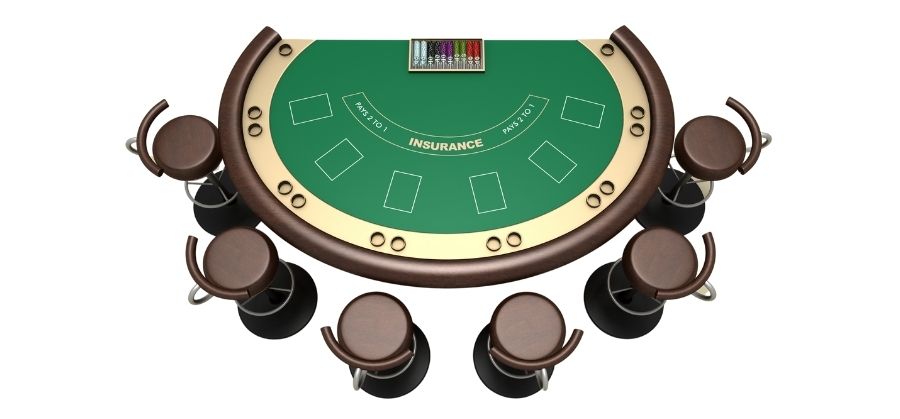
Advanced Blackjack Strategies
Once you've played enough to know the blackjack charts by heart, you're probably wondering if you can take the house edge even lower. Well as it turns out, you can. In this section, we will discuss more advanced strategies that are guaranteed to take your game knowledge up a couple notches.
However, we do have to note that these strategies do carry a bit of risk. What we mean by this is that, if you tried to use these strategies when you play live blackjack in Canada or elsewhere, you run the risk of being kicked out of—or worse, banned from—the casino. But if you choose to shoulder this risk and truly master the techniques, you can reverse the casino advantage and get the chance to bring down the house.
Card Counting
Of the advanced strategies we will cover in this article, card counting is arguably the most well-known. This technique was used most notably by the MIT Blackjack Team, throughout the 80s and 90s. Counting cards is one of the most effective advantage play strategies in any casino game. It has been found to tip the statistical advantage in the player's favour by as much as 4% (although in practice, this figure was closer to 2% for most card counters).
Despite its complexity in execution, card counting is conceptually very simple. At its core, card counting is a system of tracking the cards that come into and out of play with a basic point system. This strategy operates on the idea that one has a better chance of winning if there are more high-value cards left in the shoe.
Now, to actually use card counting effectively in a blackjack game, one needs to first:
- Master basic strategy;
- Memorize the counting system you want to use;
- Quickly make mental notes of the cards that came into play; and
- Maintain and adjust the running count as the deck evolves over time.
Besides that, you have to be aware of the various point systems used in card counting. But for simplicity's sake, we'll describe the process of card counting with the Hi-Lo system. which assigns point values based on the following table:
| Card | 2 | 3 | 4 | 5 | 6 | 7 | 8 | 9 | 10, J, Q, K | A |
| Value | +1 | +1 | +1 | +1 | +1 | 0 | 0 | 0 | -1 | -1 |
With all that in mind, the card counting process goes like this:
- The player starts their count when the shoe is reshuffled. A fresh shuffle resets the count and allows the player to properly track all of the cards.
- The player plays the game at the minimum bet (to maximize their bankroll) and updates their running count based on the cards that have been dealt.
- For example, consider a two-player game with the following cards: 4, A, 6, 10, 7, 8. Based on our Hi-Lo system, 4 and 6 give +1 each, 7 and 8 give 0, and 10 and A give -1. As such, our running count comes out to 0.
- The player calculates the true count based on their running count by dividing the running count by the number of decks remaining in the shoe.
- As an example, a 6-deck game with a running count of 12 after the first deck will give us a true count of 2.4 (typically rounded down), since we divide 12 by 5.
- The player changes their decisions when the game has a good true count. The general strategy is to increase their bets on a good true count, but more skilled counters will actually move away from basic strategy as their game sense finds that they have a better chance of winning the hand in unique cases.
Edge Tracking & Shuffle Tracking
Although these two strategies each have their nuances, edge tracking and shuffle tracking can generally be lumped together. This is because both strategies take advantage of subtleties in the decks to predict what cards are likely to appear at certain points in the game.
Edge tracking is arguably the easier of the two, and makes use of keen eyes to find subtle imperfections in certain desirable cards so they can be tracked through the deck.
Shuffle tracking, meanwhile, tracks certain groups of cards (usually those with high values) in a section of the deck as they come into and out of play. This strategy works most effectively on games with larger shoes, as the number of decks makes it difficult to perform more thorough shuffles. As such, the target groups are more likely to remain intact through the shuffle.
Use Blackjack Strategy to Ace Your Games
There are few experiences quite as thrilling as learning blackjack strategy and seeing it pay off on the table. As one of the only casino games with real opportunities for advantage play, blackjack holds the rare status of being very rewarding to learn.
Whether you're a regular looking to learn counting or a newbie using a strategy chart, blackjack has a lot in store for you, and we hope that this strategy guide has put you on the path to mastering the game.
Blackjack Strategy FAQs
What is the best strategy for blackjack?
By far the most successful strategy you can use at the table is, of course, basic strategy. As we've already discussed, basic strategy has been proven through tens of thousands of games over the years to be the single most effective technique for reducing the house edge. While it's hard to say if there truly is a perfect blackjack strategy, basic strategy is about as close as we can get.
How do you win consistently in blackjack?
At risk of sounding like a broken record, mastering basic strategy is the single most reliable way to win consistently in blackjack. Besides being highly optimized, basic strategy is also risk-free; in other words, using basic strategy at a blackjack table in Canada won’t get you kicked out by the casino (unlike advantage plays like card counting).
Should I take an insurance bet?
The short answer is no. The insurance bet is a side bet that wagers an additional half of your original bet when the dealer upcard is an ace. Because the dealer generally has about as low of a chance of getting a blackjack as the player, it is never a good idea to take insurance.
Should you split 10s?
In standard blackjack, basic strategy dictates that you should never split 10s. This is because a hand of 20 is about as good as it gets, and will be very hard for the dealer to beat outside of an outright blackjack. Splitting your 10s here would only ruin an almost guaranteed win.
However, there are some instances wherein splitting 10s can actually be a good idea. The most notable example is in Double Exposure Blackjack, a variant of the game in which both of the dealer's cards are dealt face up, allowing players to immediately know the dealer's hand.
Keeping this and other rules in mind, then, basic strategy for double exposure blackjack is slightly different. In particular, splitting 10s is now advantageous for the player when the dealer has a hand of 13 to 16. Splitting here gives you another hand with which to beat the dealer's, which is relatively easy given the dealer's lower value hand.
Should I split aces in blackjack?
If splitting 10s in standard blackjack is a bad idea, splitting aces is the opposite. Referring back to basic strategy, we find that one should always split aces in standard blackjack. And if we break down the game logic to its simplest form, we can understand why.
As we already know, aces hold a value of 1 or 11 depending on which is more valuable to the hand. This means that, because two 11s will make the hand go bust, the final value of two aces is 12. Splitting our hand in this case will allow each ace to carry its maximum value and get another hand with its own separate chance of winning.
